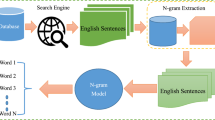Abstract
In order to improve the accuracy of situational English language information intelligent retrieval and shorten the retrieval time, a situational English language information intelligent retrieval algorithm based on wireless sensor network is proposed. Firstly, the principle of situational English information intelligent retrieval algorithm is analyzed. Then, the model based on wireless sensor network is established, including the establishment of communication model and communication routing mechanism. Finally, the intelligent retrieval of situational English information is realized through information filtering, probability retrieval model, organization and storage of structured documents and secondary filtering. The experimental results show that the situational English language information intelligent retrieval algorithm of this study has high accuracy and can effectively shorten the retrieval time.









Similar content being viewed by others
Data Availability
All data, models, and code generated or used during the study appear in the submitted article.
Change history
07 November 2022
This article has been retracted. Please see the Retraction Notice for more detail: https://doi.org/10.1007/s10776-022-00584-5
References
Y. Qiang, X. Yang, J. Zhao, et al., Lung nodule image retrieval based on convolutional neural networks and hashing[J], Journal of Beijing Institute of Technology, Vol. 28, No. 01, pp. 21–30, 2019.
B. Wang, Z. Tian, W. Zhang, et al., Retrieval of green-up onset date from modis derived ndvi in grasslands of inner mongolia[J], IEEE Access, Vol. 7, No. 1, pp. 77885–77893, 2019.
K. S. Arun, V. K. Govindan and S. D. M. Kumar, Enhanced bag of visual words representations for content based image retrieval: a comparative study [J], Artificial Intelligence Review, Vol. 53, No. 3, pp. 1615–1653, 2020.
P. Zhou, K. Wang, J. Xu, et al., Differentially-private and trustworthy online social multimedia big data retrieval in edge computing [J], IEEE Transactions on Multimedia, Vol. 21, No. 3, pp. 539–554, 2019.
Q. Men and H. Leung, Retrieval of spatial-temporal motion topics from 3D skeleton data [J], Visual Computer, Vol. 35, No. 8, pp. 973–984, 2019.
R. Freij-Hollanti, O. W. Gnilke, C. Hollanti, A. L. Horlemann-Trautmann, D. Karpuk and I. Kubjas, $t$ -private information retrieval schemes using transitive codes, IEEE Transactions on Information Theory, Vol. 65, No. 4, pp. 2107–2118, 2019.
T. Vale and E. S. De Almeida, Experimenting with information retrieval methods in the recovery of feature-code SPL traces [J], Empirical Software Engineering, Vol. 24, No. 3, pp. 1328–1368, 2019.
S. R. Mashwani and S. Khusro, 360° semantic file system: augmented directory navigation for nonhierarchical retrieval of files [J], IEEE Access, Vol. 7, No. 1, pp. 9406–9418, 2019.
G. Baechler, M. Krekovic, J. Ranieri, et al., Super resolution phase retrieval for sparse signals [J], IEEE Transactions on Signal Processing, Vol. 67, No. 18, pp. 4839–4854, 2019.
E. Yaakobi and J. Bruck, On the uncertainty of information retrieval in associative memories [J], IEEE Transactions on Information Theory, Vol. 65, No. 4, pp. 2155–2165, 2018.
Y. P. Wei and S. Ulukus, The capacity of private information retrieval with private side information under storage constraints [J], IEEE Transactions on Information Theory, Vol. 66, No. 4, pp. 2023–2031, 2020.
J. Lavauzelle, Private information retrieval from transversal designs [J], IEEE Transactions on Information Theory, Vol. 65, No. 2, pp. 1189–1205, 2019.
K. Banawan and S. Ulukus, Asymmetry hurts: private information retrieval under asymmetric traffic constraints [J], IEEE Transactions on Information Theory, Vol. 65, No. 11, pp. 7628–7645, 2019.
S. Kadhe, B. Garcia, A. Heidarzadeh, et al., Private information retrieval with side information[J], IEEE Transactions on Information Theory, Vol. 66, No. 4, pp. 2032–2043, 2017.
Y. P. Wei, K. Banawan and S. Ulukus, The capacity of private information retrieval with partially known private side information [J], IEEE Transactions on Information Theory, Vol. 65, No. 12, pp. 8222–8231, 2017.
T. Mutton and D. Ridley, Understanding similarities and differences between two prominent web-based chemical information and data retrieval tools: comments on searches for research topics, substances, and reactions, Journal of Chemical Education, Vol. 96, No. 10, pp. 2167–2179, 2019.
N. Goyal, M. Dave and A. K. Verma, Data aggregation in underwater wireless sensor network: Recent approaches and issues [J], Journal of King Saud University - Computer and Information Sciences, Vol. 31, No. 3, pp. 275–286, 2019.
Pascal Lorenz, et al., New path centrality based on operator calculus approach for wireless sensor network deployment, IEEE Transactions on Emerging Topics in Computing, Vol. 7, No. 1, pp. 162–173, 2019.
I. Benkhelifa, S. Moussaoui and I. Demirkol, Intertwined localization and error-resilient geographic routing for mobile wireless sensor networks [J], Wireless Networks, Vol. 26, No. 3, pp. 1731–1753, 2018.
M. Kanthimathi, R. Amutha and K. S. Kumar, Energy efficiency analysis of differential cooperative algorithm in wireless sensor network [J], Cluster Computing, Vol. 22, No. 12, pp. 1–9, 2019.
S. Sivasakthiselvan and V. Nagarajan, A new localization technique for node positioning in wireless sensor networks [J], Cluster Computing, Vol. 22, No. 1, pp. 4027–4034, 2019.
Author information
Authors and Affiliations
Corresponding author
Additional information
Publisher's Note
Springer Nature remains neutral with regard to jurisdictional claims in published maps and institutional affiliations.
Rights and permissions
Springer Nature or its licensor (e.g. a society or other partner) holds exclusive rights to this article under a publishing agreement with the author(s) or other rightsholder(s); author self-archiving of the accepted manuscript version of this article is solely governed by the terms of such publishing agreement and applicable law.
About this article
Cite this article
Ye, Q. RETRACTED ARTICLE: Situational English Language Information Intelligent Retrieval Algorithm Based on Wireless Sensor Network. Int J Wireless Inf Networks 28, 287–296 (2021). https://doi.org/10.1007/s10776-021-00516-9
Received:
Revised:
Accepted:
Published:
Issue Date:
DOI: https://doi.org/10.1007/s10776-021-00516-9




